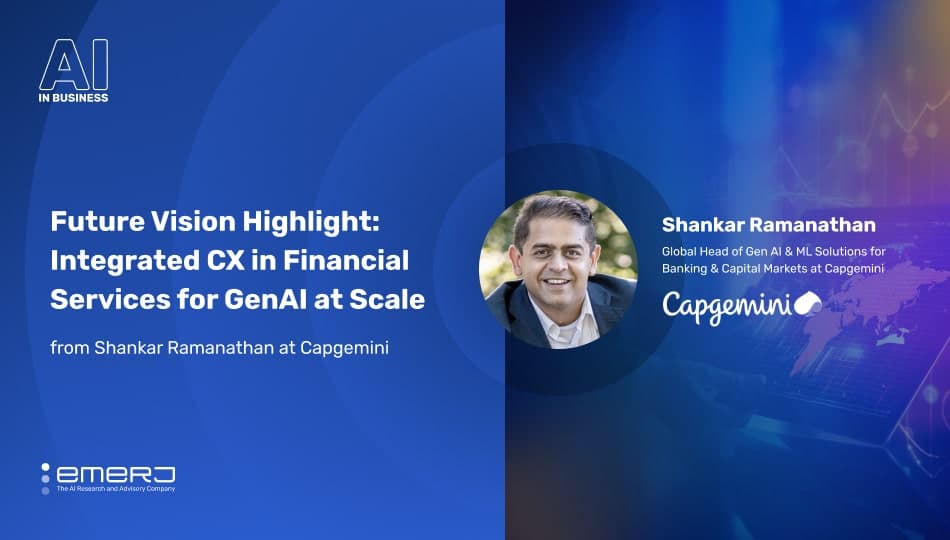In a global economy where customer experience (CX) is the ultimate competitive battleground for so many sectors, businesses across industries face daunting challenges in scaling CX solutions effectively. Despite massive investments in customer service technologies, many companies need help to deliver consistent, personalized support that meets user expectations, leading to frustration, lost revenue, and damaged reputations.
Shankar Ramanathan is Head of Generative AI (GenAI) & Machine Learning Solutions for Banking & Capital Markets at Capgemini. Shankar recently sat down with Emerj Head of Research Daniel Fagella to discuss what he sees as the future of CX, where AI-driven workflows could change the game.
Through Shankar’s correspondence with Emerj, he offered a comprehensive vision for how businesses can solve these problems by embracing agentic workflows, making sense of the structured and unstructured data necessary to produce these capabilities, and enhancing user experience through more intuitive systems.
According to Shankar’s vision, implementing the data governance necessary to help systems that understand and anticipate customer intuition will also help companies understand how to effectively implement concepts like agentic architecture. Companies like Capgemini are at the forefront of deploying these advanced tools, avoiding common scaling pitfalls, and helping others in the Fortune 500 deploy systems that work seamlessly at scale.
The following subsections summarize three critical insights for business leaders leveraging the latest technology to solve customer pain points:
- Why CX at scale fails without user buy-in, and how to fix it
- How AI-driven workflows simplify CX across structured and unstructured data
- Why the future of CX is about making AI intuitive and accessible to non-technical users
Guest: Shankar Ramanathan, Head of Generative AI (GenAI) & Machine Learning Solutions for Banking & Capital Markets, Capgemini
Expertise: GenAI and Decisions Consulting, Sales, Architecture, Solutioning, Collections
Brief Recognition: Shankar Ramanathan has spent the last several years at Capgemini, where he plays a pivotal role in driving AI and customer experience (CX) transformations. He is known for his thought leadership in financial services and digital transformation, regularly contributing to white papers, industry reports, and key initiatives within the sector. Ramanathan’s expertise lies in integrating advanced technologies like large language models (LLMs) into CX frameworks to streamline business processes and elevate customer engagement at scale.
Understanding Context Switching and the Single-Action Model
Context-switching, or the interruption of a task due to shifting between platforms or channels, is a significant source of friction in customer interactions. Ramanathan emphasized the frustration customers face when they need to repeat details across multiple channels or platforms, noting that the same friction extends beyond CX to software development.
The concept of a single-action model aims to alleviate these tensions by creating a seamless, unified experience where each customer interaction occurs within a single, consistent interface.
Ramanathan explained that as more companies realize the financial impact of context-switching—lost productivity, customer dissatisfaction, and attrition—the urgency to address these inefficiencies grows. He suggests that the single-action model’s impending rise across industries will drive businesses to reduce context-switching by consolidating disparate CX channels, which will ultimately lead to better service and customer loyalty.
Agentic Systems and Their Impact on CX and Infrastructure
Agentic systems refer to cutting edge AI capabilities that allow systems to work across multiple platforms and digital surfaces at once, representing a potentially disruptive step-level advancement in automatable and generative workflows alike. Agentic systems will not only undergird the data that drives single-action models in the enterprise but also serve as the basis for digital agents that will carry out customer-facing and back-office tasks alike.
Ramanathan firmly believes that agentic systems represent a transformative approach to CX that leverages AI to address customer needs proactively. Unlike traditional reactive systems, agentic systems predict user actions and adjust responses in real time, creating smoother customer journeys.
These systems operate on an autonomous level – meaning without human input other than the customer – anticipating what customers may need before they explicitly ask for it. To minimize the dependence on prompts or clicks for navigation, companies can explore more customer-friendly architectures for their interfaces.
Ramanathan described how agentic systems will impact CX infrastructure, as they necessitate a shift in backend systems. Traditional customer service infrastructures, often rigid and rule-based, are not conducive to these dynamic, self-initiated systems. By focusing on the infrastructure that supports autonomous responses, businesses can streamline interactions and deliver more personalized service.
He notes the relative scalability and adaptability of agentic systems, which, in particular, make them ideal for companies looking to overhaul outdated CX infrastructures and optimize resource allocation.
Simplifying CX with AI-Driven Workflows
The challenge for launching such advanced systems is that businesses often have to integrate disparate data sources, manage structured and unstructured data, and create systems that actually help employees work smarter, not harder.
Ramanathan paints a clear vision of how AI can take on more complex roles within the CX framework by acting as an executive assistant for workers, particularly in finance or customer service.
Shankar suggests deploying an AI assistant to help professionals like fraud investigators, underwriters, and financial planners by making sense of vast amounts of information and reducing the cognitive load on human employees.
A recent conversation Emerj had with MindBridge CTO Matthias Steinberg touched on a similar point regarding the long-term value of use cases in fraud detection and other anomaly-detection-based workflows across corporate financial teams and how they fuel scaling more advanced AI initiatives and insights through the enterprise.
How to Build AI-Powered Workflows that Add Value
To implement these systems, Ramanathan insists businesses first need to ensure their AI tools are designed with human needs in mind. According to Ramanathan, AI should serve as an intuitive, easy-to-use assistant that helps employees make better decisions faster. Customer experiences should always be manageable for users, never burdening them with excessive data or complicated processes.
Shankar finds that the most valuable aspect of AI-driven workflows is when they can help a person identify an exception in the data, find correlations across data sources, or complete tasks with minimal input. These insights not only boost efficiency but also allow the human element to remain critical in decision-making, ensuring that AI supports rather than replaces the workforce.
By triangulating across different data sources and using AI to manage the manual labor of sorting through structured and unstructured data, CX can become more seamless and practical.
The Power of GenAI Combined with Agentic Systems
Toward the end of the discussion, Ramanathan highlighted a key benefit of integrating GenAI with agentic systems: enhanced customer experience efficiency through user history insights.
GenAI’s ability to create detailed customer interaction histories is invaluable for agentic systems, which rely on contextual data to function effectively. By combining these technologies, companies can enhance response accuracy and maintain a record of each customer’s preferences, improving response relevance and reducing wait times.
Ramanathan noted that businesses using GenAI to consolidate user history within agentic systems experience new realms of efficiency, with automated personalization adjusting in real-time to customer needs. The ensuing symbiotic relationship between GenAI and agentic systems offers the opportunity to increase productivity and customer satisfaction, addressing some of the most considerable CX pain points through a holistic approach to AI-driven insights.
Actionable Steps for Business Leaders
To make advanced AI systems like agentic models AI work for customer experience workflows across industries, business leaders need to:
- Focus on the user interface: Make sure AI-driven systems are simple and intuitive, requiring minimal training.
- Integrate data sources: Build systems that can quickly pull from structured and unstructured data to provide employees with actionable insights.
- Provide executive assistant-like tools: Create AI tools that assist employees in managing their workflows, allowing them to focus on high-value tasks rather than repetitive manual ones.



















